© Copyright 2020 Foshan Membrane Technology Co., Ltd. All rights reserved. Sitemap
The present research aimed to investigate the influence of layer arrangement and composition ratio on tensile and transport properties in bi-constituent electrospun nanofibrous membranes composed of polyurethane nanofibers with a hydrophobic nature and poly(2-acrylamido-2-methylpropanesulfonic acid) with a hydrophilic nature. Different hybrid electrospun nanofibrous membranes were produced based on different layer arrangement and composition ratios. To evaluate the membrane performance, their tensile strength, wind, and waterproof performance were measured. By adding 50% poly(2-acrylamido-2-methylpropanesulfonic acid) to polyurethane, the pore size of the hybrid electrospun nanofibrous membranes decreased by 47.64%. As a result, compared with pristine polyurethane membranes, hybrid electrospun nanofibrous membranes showed a good (9.6 mm s(-1)) windproof performance. Adding poly(2-acrylamido-2-methylpropanesulfonic acid) nanofibers to the polyurethane resulted in a decrease in mechanical properties and waterproof performance. The results show that the volume fraction of the poly(2-acrylamido-2-methylpropanesulfonic acid) and the electrospinning scenarios have a great influence on the mechanical properties of the samples. The results also show that the mechanical properties of hybrid electrospun nanofibrous membranes can be predicted based on the geometrical properties of each component. Computational fluid dynamics were used to simulate air flow through a virtual medium and the results of simulation were compared with the experimental measurement and predicted permeability; then, the best models for predicting air permeability were determined. In addition, based on different types of use, duration of use, and relative humidity level, a bi-functional membrane can be obtained by regulating layer arrangement and composition ratios to suit various applications, for example, in medical disposable clothing, wound dressing, filtering industries, and protective clothing.
本研究旨在研究层结构和组成比对具有疏水性的聚氨酯纳米纤维和具有亲水性的聚(2-丙烯酰胺基-2-甲基丙烷磺酸)组成的双组分电纺纳米纤维膜的拉伸和传输性能的影响。基于不同的层布置和组成比,产生了不同的混合电纺纳米纤维膜。为了评估膜的性能,测量了它们的拉伸强度,抗风性和防水性能。通过将50%的聚(2-丙烯酰胺基-2-甲基丙烷磺酸)添加到聚氨酯中,杂化电纺纳米纤维膜的孔径减小了47.64%。结果,与原始聚氨酯膜相比,混合电纺纳米纤维膜表现出良好的(9.6 mm s(-1))防风性能。将聚(2-丙烯酰胺基-2-甲基丙烷磺酸)纳米纤维添加到聚氨酯中导致机械性能和防水性能下降。结果表明,聚(2-丙烯酰胺基-2-甲基丙烷磺酸)的体积分数和电纺丝方案对样品的力学性能有很大的影响。结果还表明,可以基于每种组分的几何性质来预测杂化电纺纳米纤维膜的机械性质。计算流体动力学用于模拟通过虚拟介质的空气流动,并将模拟结果与实验测量值和预测的渗透率进行比较;然后,确定预测透气性的最佳模型。此外,根据不同的用途,使用时间和相对湿度水平,可以通过调节层的排列和组成比来获得双功能膜,以适应各种应用,例如医用一次性衣服,伤口敷料,过滤工业和防护服。

Published: 2020
Journal :Journal of Industrial Textiles
Impact Factor:2.455
Paper link: https://journals.sagepub.com/doi/abs/10.1177/1528083720917948